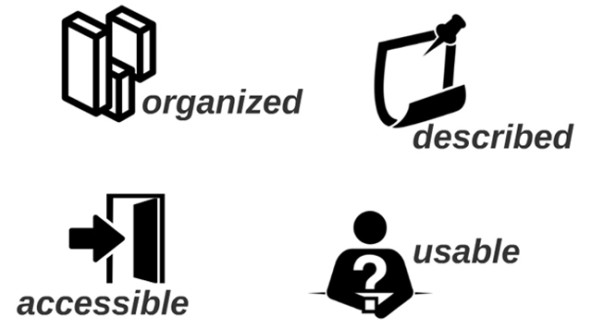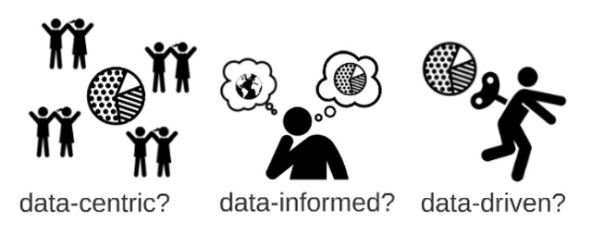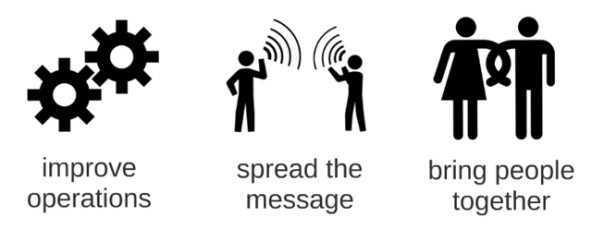Picture yourself in that meeting. You know you've been there—the one where Sally from communications run through the latest counts of your Twitter followers and Facebook engagements. You wonder what an "engagement" even is. You ponder: Is that number even useful? Is this the kind of data our organization needs? Is this the way we should be using data?
And good for you! Those are the right questions to ask. Data is hot right now—too hot. The key to cutting through the data hype is an almost contrarian viewpoint in our data-everywhere culture right now: learn to use data on purpose
At SSIR’s recent Data on Purpose conference, I led a workshop on building “data architectures” for your organization. To use data effectively, organizations need architectures—people, process, and technology-driven structures that support the effective and intentional use of data to further their mission—for data management, data security, data culture, and data use. Here is an introduction to each of these, to help you take a step back and make sure that your organization is using data in the right ways.
1. Architectures for Data Management
Are you enjoying this article? Read more like this, plus SSIR's full archive of content, when you subscribe.
Your data will be a spaghetti-like mess unless you install some plumbing to help organize things. The systems you implement, of course, should meet the needs and scale of your organization's data. I break this down into four criteria: You need to make sure your data is organized (stored in a consistent structure), well described (documented formally or informally so folks know what it is and where it came from), accessible (easy available for folks to find and use), and usable (stored in a format people in your organization know how to wrangle).
 Evaluating architectures for data storage. (Image by Rahul Bhargava with icon from the Noun Project)
Evaluating architectures for data storage. (Image by Rahul Bhargava with icon from the Noun Project)
How do you accomplish these four things? There are lots of options; you have to pick one that fits the needs of your team. Random spreadsheets scattered between people's computers aren't organized, well described, or accessible. A central file server (such as SharePoint or Dropbox) might help make these files more accessible, but without templates or standard formats they won't be well described or usable. A web-based portal (such as ckan or Socrata) will certainly make data more usable, but it might not guarantee that all of it is well organized.
You need to find an architectural solution in this space of tools and structures that meets those four criteria.
2. Architectures for Data Security
Data security. There, I said it. Don't leave yet—trust me, this won't be super boring! Securing any digital information is difficult. To create an architecture for data security, you need to consider what security means to you and what policies, practices, and tools can meet those needs. You don't want to end up with a security solution that doesn't match your data needs. Don't start using two-factor authentication with crazy USB dongles if your data isn't hypersensitive or personally identifiable.
That said, there are a few issues to consider. You need to protect against technical vulnerabilities—potential cracks in the software you use to store your data—but also look at social vulnerabilities; be aware of how people get tricked into releasing information. This process, called “social engineering,” involves getting people to give up the answers to things like security questions that are intended to be an extra layer of protection. (People are surprisingly willing to give up personal information about themselves when asked in an official-sounding way!) There are external threats—the classic "hacker stole my data" storyline—but recently folks are much more worried about internal threats, or the risks of someone inside your organization "going rogue."
Start with a simple definition of the types of data you have and consider how worried you are about each type getting out of your hands.
3. Architectures for Building a Data Culture
Skepticism aside, data-driven storytelling is clearly a core new skill that organizations need in their toolboxes for creating change in the world. Decide what kind of culture you want to build within your organization. Are you going to be data-centric and make data the central driver of group decision-making processes? Are you going to be data-driven and do whatever the data tells you to do? Or are you going to be data-informed, and view the data and its context as inputs into your decision-making process? You won't be surprised to hear that the last is usually the best approach.
 Three types of data cultures—which do you want? (Image by Rahul Bhargava with icon from the Noun Project)
Three types of data cultures—which do you want? (Image by Rahul Bhargava with icon from the Noun Project)
But how do you build a data-informed culture? Begin by looking within your organization for people who are already using data in good ways, and hold them up as models for others. If you have lots of data, perhaps create a chief data officer position to coordinate data use across the organization and fight existing data silos. Organizations need to integrate data from both the top-down and bottom-up.
4. Architectures for Data Use
 Some ways to use your data. (Image by Rahul Bhargava with icon from the Noun Project)
Some ways to use your data. (Image by Rahul Bhargava with icon from the Noun Project)
Remember that data is an asset that can help you do your work more effectively. You want to build architectures within your organization so that your use of data aligns with your goals and mission. Don't do data for data's sake! Some examples: Use your data to monitor your operations (remember Sally and her "engagements" on Facebook), or in external communications to spread the message by advocating and communicating about your issue in new and visually appealing ways. You can also bring people together around data, analyze it in creative and fun ways, and find stories to tell with it (maybe even design and paint a data mural or two).
No matter what, all of these efforts need to reinforce and align with your organization’s goals. A beautiful, external-facing infographic that doesn’t fit into your ladder of engagement or doesn’t include a call to action is useless. A dashboard showing key performance indicators doesn’t mean much if they’re not the right indicators. Setting up these four architectures will help your organization "speak data" in intentional ways and ultimately do data on purpose.
Support SSIR’s coverage of cross-sector solutions to global challenges.
Help us further the reach of innovative ideas. Donate today.
Read more stories by Rahul Bhargava.

